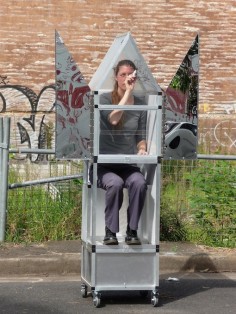Astra Howard
The Heightened Drawing Platform
source: astrahoward
Description: The Heightened Drawing Platform was inspired by the tall, slender, weathered vaults of the Père Lachaise cemetery in Paris as well as by 13th Century Byzantine icons. The vaults were typically constructed with triangular or ogival copper archways and the figurative icons often sat within a golden archway, which illuminated faces and torsos creating a heightened sense of poise and ethereal stature. The characters within these embellished spaces appeared to gaze out to the onlooker from the security of their cloistered environment, having witnessed and withstood centuries of observers watching them and some even making copies in pencil and paint. The ‘icon’ in the ‘Heightened Drawing Platform’ came to life in Sydney, embodied by the Action Researcher/Performer sitting inside a purpose built vehicle observing and being observed by, passing members of the public. In this case, the ‘icon’ herself adopted the pen and the act of drawing, revealing the ‘other/outer’ side of the picture, what was otherwise hidden in the surrounding environment. The mirrors on either side of the central viewing space were simultaneously used as devices to gain further ‘unseen’ perspectives or to witness momentary acts, reflected back into the delineated images of the city. The Action Researcher/Performer drew quickly across the mirrored surface in order to capture the dynamic ever-shifting view outside.
.
.
.
.
.
.
.
source: astrahoward
Astra Howard is an Action Researcher/Performer working predominantly within public spaces in cities. Since 1998 Astra has designed and produced site-specific works under the banner of CityARC, (the City Action Research Centre) in cities across Australia, and internationally, including: Beijing, Paris, New York, Delhi, Hanoi and London. After completing a PhD in 2005 titled: ‘Orchestrating the Public: To Reveal and Activate through Design the Experience of the City’, Astra has continued to test urban and social theories in the city spaces they critique. Undertaking various projects commissioned by city councils, state government departments and community/arts organizations, Astra has designed and directed these projects using original iterative research methodologies. Information is gathered about a location, the data collected and visualised, which in turn generates dialogue and debate amongst members of the public about issues affecting their city. At the same time as producing these public projects, Astra has worked professionally as a designer in commercial agencies, as a lecturer in the higher education sector and as a community development worker, predominantly in crisis homeless services. The varied collaborative projects undertaken within these employment roles have not been uploaded to this website.
.
.
.
.
.
.
.
source: redobjectsunsweduau
Supervised by Wendy Parker & Dr Jill Bennett
Astra Howard designs and produces public space Action Research/Performance works in cities across Australia and Internationally in such diverse locations as Beijing, Paris, New York and Delhi. These projects use experimental research methodologies to gather information about a location, visualize the data collected, generate dialogue and debate amongst members of the public and as a consequence, reinvigorate city spaces. Astra’s evolving series of interactive vehicle/booth constructions seek to stimulate sensorial interaction between the researcher and the public (The Trojan Horse Effect), disabling normal means of communication in order to encourage and facilitate more genuine and intimate responses.
Abstract
This thesis aims to develop an art and design based methodology to explore the range and quality of interactive experiences people have within urban public spaces. Urban geographers and social theorists such as Kevin Lynch and Jane Jacobs argue that in an increasingly urbanised world, the metropolis is burdened by the limitations of an undeveloped language and taxonomy of space. Consequently the interactions and outcomes that make up a person’s city public space relationship remain largely unknowable.
From my earlier work with homeless people I was aware that the quality of experience of a city was often dependent upon the degree and nature of interaction a person had with a particular place or series of spaces. This interactive dynamic of participation relating to a single person or group is the focus of my thesis, which sits within the broader field of urban studies. My methodology, however, is derived from the practice and traditions of performance art as well as the structured approach of a designer.
To address this problem, I have created an investigative character, the Action Researcher/Performer. This engaged participant acts as a transducer interacting and mediating between current theoretical arguments, public spaces themselves and the people who occupy them. To explore, assess test and extend a diverse range of experiences, more than eighty experimental projects have been undertaken, within the diverse geopolitical urban contexts of Sydney, Beijing, Paris, New York and Delhi.
I produced these projects by developing and then applying two, inter-dependent propositions. Firstly that an action research model could be designed and employed to provide maximum penetration into urban space experience, and secondly, that the design and application of the model could best occur within an innovative, cross-disciplinary and experimental methodology.
This overall process was the key to providing new descriptions of, and insights into, the operation of public spaces and to discovering qualities and conditions people responded to positively or negatively. I have created a diagnostic tool that successfully and reliably reveals, amplifies and/or demonstrates otherwise dormant or undetectable conditions of interactivity that exists between individuals and urban public spaces.


